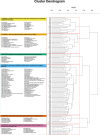Food additives: distribution and co-occurrence in 126,000 food products of the French market
- PMID: 32132606
- PMCID: PMC7055242
- DOI: 10.1038/s41598-020-60948-w
Food additives: distribution and co-occurrence in 126,000 food products of the French market
Abstract
Background: More than 330 food additives (e.g. artificial sweeteners, emulsifiers, dyes) are authorized in Europe, with a great variability of use across food products.
Objective: The objective of this study was to investigate the distribution and co-occurrence of food additives in a large-scale database of foods and beverages available on the French market.
Design: The open access crowdsourced Open Food Facts database (https://world.openfoodfacts.org/) was used to retrieve the composition of food and beverage products commonly marketed on the French market (n = 126,556), based on the ingredients list. Clustering of food additive variables was used in order to determine groups of additives frequently co-occurring in food products. The clusters were confirmed by network analysis, using the eLasso method.
Results: Fifty-three-point eight percent of food products contained at least 1 food additive and 11.3% at least 5. Food categories most likely to contain food additives (in more than 85% of food items) were artificially sweetened beverages, ice creams, industrial sandwiches, biscuits and cakes. The most frequently used food additives were citric acid, lecithins and modified starches (>10,000 products each). Some food additives with suspected health effects also pertained to the top 50: sodium nitrite, potassium nitrate, carrageenan, monosodium glutamate, sulfite ammonia caramel, acesulfame K, sucralose, (di/tri/poly) phosphates, mono- and diglycerides of fatty acids, potassium sorbate, cochineal, potassium metabisulphite, sodium alginate, and bixin (>800 food products each). We identified 6 clusters of food additives frequently co-occurring in food products.
Conclusions: Food additives are widespread in industrial French products and some clusters of additives frequently co-occurring in food products were identified. These results pave the way to future etiological studies merging composition data to food consumption data to investigate their association with chronic disease risk, in particular potential 'cocktail effects'.
Conflict of interest statement
The authors declare no competing interests.
Figures






References
-
- Adams J, White M. Characterisation of UK diets according to degree of food processing and associations with socio-demographics and obesity: cross-sectional analysis of UK National Diet and Nutrition Survey (2008–12) Int. J. Behav. Nutr. Phys. Act. 2015;12:160. doi: 10.1186/s12966-015-0317-y. - DOI - PMC - PubMed
Publication types
MeSH terms
Substances
LinkOut - more resources
Full Text Sources

